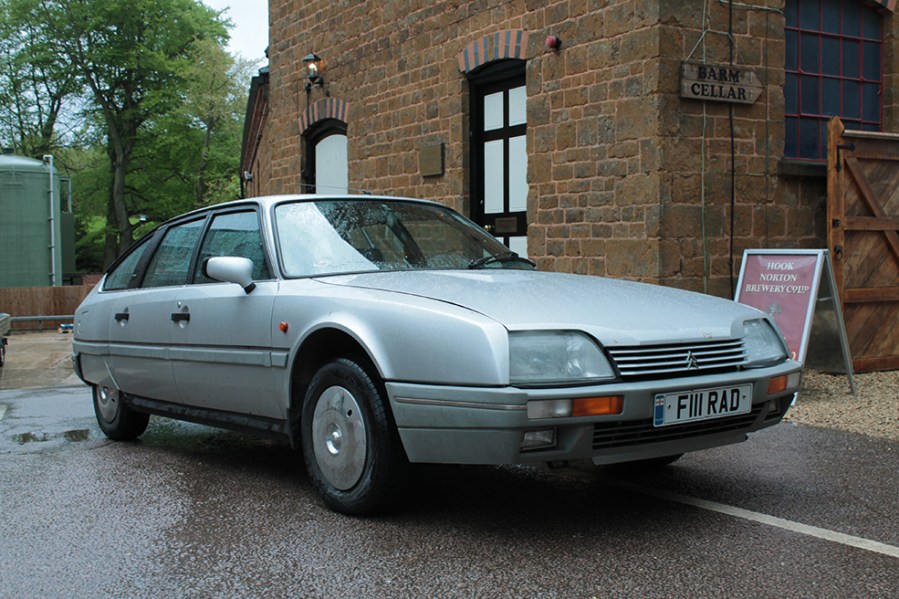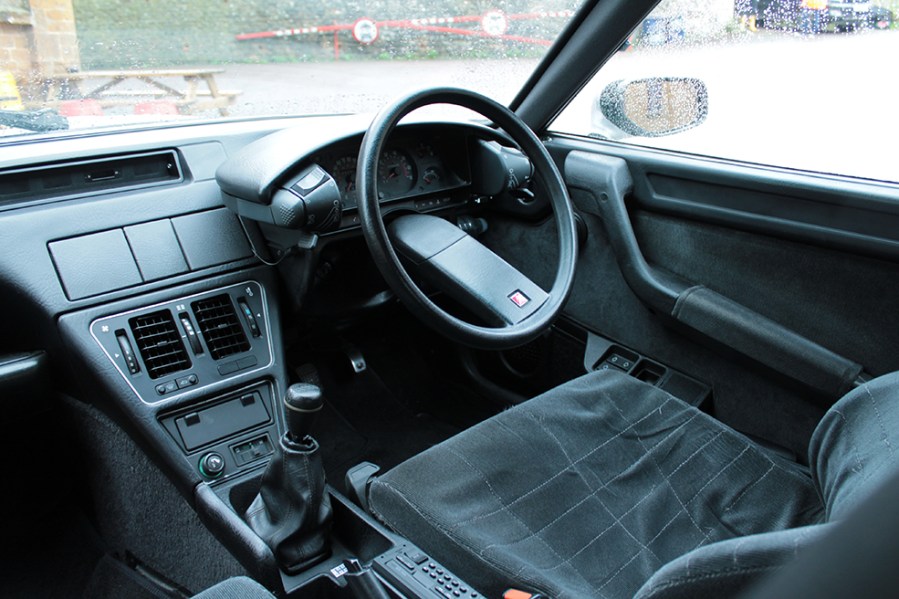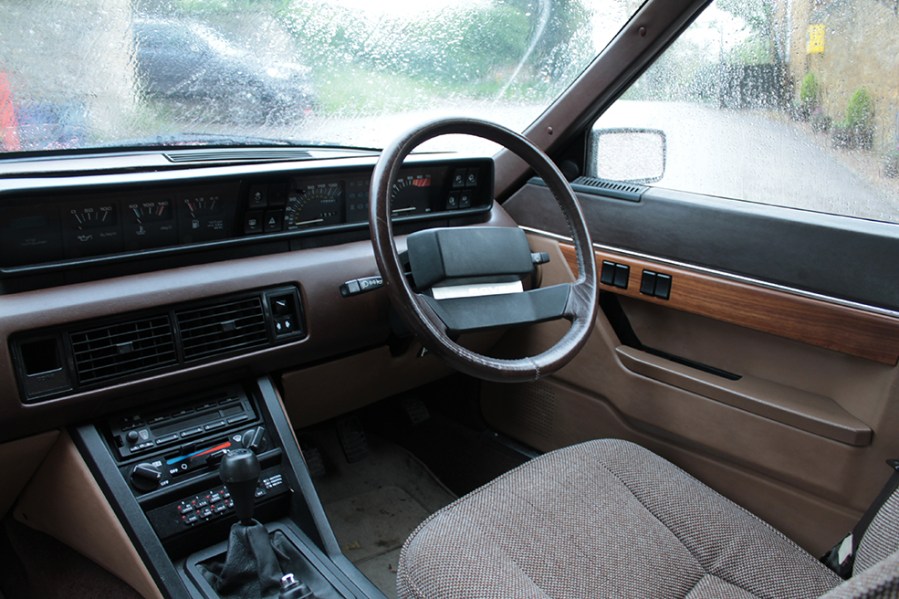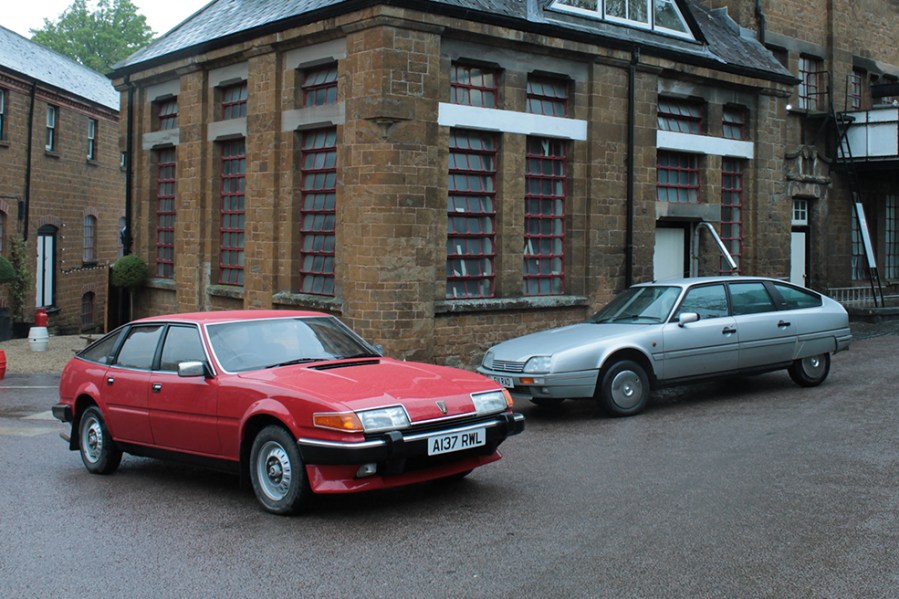The Citroën CX was perhaps the most advanced executive car of 70s and 80s. How does it compare to its simpler Rover SD1 rival?
Words: Sam Skelton
There are few cars capable of overshadowing the mighty Citroën DS when it comes to technological achievement, but if any were to be capable it would surely be its successor. The CX was more sensibly sized, more slippery in shape, and offered additional technology to boot. But in Britain its image was firmly in the niche sector owing to its complexity. British buyers were far more enamoured by the Rover SD1 – which underneath its supercar-aping body had a chassis that was distinctly old tech. Despite new engines and a late facelift, the CX just didn’t hit the same mark in Britain as the big Rover.
But worldwide, the CX sold almost three times the number the Rover managed. So was Britain unfair to the CX, or was the RoverSD1 truly the better car?
Citroën CX
Launched in the UK in 1975, 12 months before the SD1 made it to production, the CX replaced the lower echelons of the D range – the D Special and D Super. The upmarket Pallas continued, not to be replaced until the introduction of the long wheelbase CX Prestige. CX carried over its predecessor’s engines, owing to the abandonment of a triple rotor rotary engine which had been in development. CX’s first truly new engine would appear in 1979 – a new 2.0 unit shared with Renault. But the ageing engines did not prevent the CX from both appearing and truly being a technical masterpiece. Inside, you had rotating strip speedometers, a dash that looked like it belonged in a spaceship and moulded door cards, later simplified and rationalised in 1986. You had a concave rear screen, wheel spats, and very minimalist trim.
The hydraulic systems which had made Citroën famous were where the real technical audacity was. Not only did the CX feature oleopneumatic suspension as its predecessor had, but it made use of the fluid system to power the steering. Not to assist, but the steering was fully powered. Better still, it had a fully powered return. This system had originally been introduced for the SM GT car, and the CX was its only application in a right hand drive vehicle. Its successor the XM retained DIRAVI in certain specifications in left hand drive, but the engine location meant the DIRAVI unit couldn’t be fitted to the right hand side.
Estates, diesels, and even an odd clutchless manual called the C-matic followed, but the basic CX formula remained the same. Lasting until 1989 in saloon form and 1991 for the estate, the CX not only preceded the SD1 but managed to outlive it. To drive a CX is to experience a sensation like no other car – precise and yet numb steering, brakes which could shame a modern car, and suspension which offers a Gallic shrug in the direction of any minor imperfection are traits which ensure the CX has a small yet fiercely loyal following to this day.
Almost 1.2 million CXs were sold over a 16 year life, the majority in France – though some even made it behind the Iron Curtain as official cars. In Britain, it was always seen as a niche choice.
As a Series 2, this might be more conventional inside than an early CX but that’s the only comparison by which this car can be considered normal inside. The dash falls away abruptly, with a separate glovebox incorporating a shelf, and a pod with satellite controls for the driver. The radio sits by the handbrake, between the seats. The single spoke steering wheel looks like something from Joe 90. The whole thing looks alien. That’s before you remember that the steering wheel self centres after use, and realise that the indicators – on a rocker switch – do not. There are no stalks in this car, and accordingly no column based cancellation system. This is a boon on compound curve junctions.

The test car is something of a rarity – the Croisette was the only special edition sold in Britain, and despite retailing for more than the TRS model, it was actually a lower specification in some ways. The Croisette was based on the CX 20RE, a model which had been discontinued in Britain owing to slow sales and which sat beneath Britain’s now entry-level TRS. It had a number of TRS upgrades, as well as parts purloined from the GTi Turbo and unique trim. Outside, all were Pearl Grey with unique colour coded rubbing strips. It’s at this point that I must confess to a personal bias; I’ve owned the featured CX for a year, and it’s not the first CX of which I have been a fortunate custodian.
The engine note seems at odds with the initial experience. Yes, it’s smooth for a four, but as you sit in the car waiting for it to rise from its recumbent idle pose the sound of a gas turbine or an electric motor might seem more fitting. Likewise, it would be better as an automatic – the long throw and notchy manual gearbox is far from the CX’s greatest feature, and while the ratios are well chosen a smooth automatic would feel more fitting. Sadly, all automatics used the larger 2.5 litre petrol, which could trace its roots back to the Traction Avant of 1934.
As with most oleopneumatic Citroëns, the ride is exemplary. You float along atop a cushion of nitrogen gas and mineral oil, smoothing out the smaller bumps and maintaining a level ride over larger ones. Potholes and speed humps alike only exist audibly. By the standards of its era the 2.2 engine in this example is brisk enough, though the manual gearbox is both notchy and oddly vague; a trait common to many CXs. All round visibility is excellent, and the super soft seats are comfortable even for longer distances. The steering takes some getting used to – there’s little feel and zero feedback, such is the nature of a powered system. But it’s so direct, that other cars feel vague in comparison. You rarely need more than two fingers to put a CX exactly where you want it.
The CX is the car for people who want the very best in engineering excellence, and to hell with the way that other people might see you. Its cerebral charms may not be for everybody – but it’s more special for it. After all, what sort of a world would we be in if everyone liked the same things?

Rover SD1
The Rover SD1 was launched in 1976, to immediate acclaim. It replaced the Rover P6 3500, though subsequent 2300 and 2600 engined Rovers would replace the P6 2200 and Triumph 2500 respectively. Wrapped up in a body as futuristic as that of the P4 had been three decades earlier, it looked more like a GT car than the contemporary Granada or Opel Commodore.
Under the bonnet nestled the Rover V8 at first, though that was expanded downwards in 1977 with a pair of new Triumph-designed sixes, and again in 1982 with the launch of the O-series engined 2000 and VM engined 2400SD Turbo. The jewel in the range’s crown, however, was the fuel injected Vitesse model launched shortly after the facelift in 1982. Originally to be called the Rapide, permission for the name was denied by owners Aston Martin and Rover dug out one of Triumph’s most sporting badges for the new flagship. 190bhp made this a fearsome road car, and a racing legend.
While an estate variant was planned and two were built as prototypes, the factory body range was always a single model, the hatchback which was seen as revolutionary for this class when launched, and which was soon aped by the Renault 30 and Audi 100 Avant. A symmetrical dashboard inside simplified production techniques; the hole on the opposite side used as part of the fresh air ventilation. Materials, at least in the early cars, were wholly man-made, reflecting a new age of engineering, and it was only with the Vanden Plas model and the wood fitted to Series 2 models that the interior ambience became more traditional. In early models, nylon cloth and plastic trim showed that the Rover, a traditionally engineering-led brand, was making use of forward thinking tech.
Sadly underneath, it owed less of its origins to the Rover design studios and the P6 layout than it did to Triumph and the simpler, cheaper, 2000-inspired layout. Independent rear suspension and the deDion tube were eschewed in favour of a love axle, and the clever cantilever front end of the P6 was simplified into Macpherson struts. It even lost the P6’s inboard rear discs, designed to reduce unsprung weight, in favour of outboard rear drum brakes. The technical side of the SD1 was wholly conventional. But that made it simple to maintain and long-lasting, qualities which endeared it to the worlds of officialdom and also subsequent performance tuners. The police and Royal Protection Squad favoured SD1s in period, as did the government, while later in life myriad performance mods became common, from fatter wheels through to 5.2 litre TVR hybrid V8 conversions.
Replaced in 1986 by the 800, many felt the new front wheel drive Honda-based car an inadequate replacement for the SD1. An enthusiast scene soon emerged, and demand has been strong almost since the end of production. Like the P5, final models were stockpiled by official bodies – this time by the Metropolitan Police, who valued the SD1 in six cylinder and V8 form as traffic cars.
A total of 303,345 SD1s were produced, including a number of CKD kits around the world. A large proportion of these were sold in Britain, and many survive in enthusiastic hands today. We’ve borrowed this 2000 from Richard Jessett; a close competitor to the entry level CX by dint of its four cylinder engine, even if it loses 200cc to the French car. Monza Red suits the SD1 shape, though it’s important to note that an early 2000 like this shouldn’t have the chrome bumper trims, headlamp washers or bib spoiler as standard. Richard has resisted the temptation to fit late style wheeltrims or alloys. Inside, the car’s got walnut door fillets and electric windows, both as a result of the difficulty in finding original base spec door cards.

The primary impression from the drivers’ seat is one of width; the Rover is a far wider feeling car than the Citroën by dint of the lower windscreen providing a widescreen view of the road outside. This is echoed by the shape of the dashboard; the horizontal yet minimal motif making the car feel far bigger than it really is. Turn the key and it’s unusual at first; anyone used to SD1s would expect a smooth six or a slightly lumpy V8 burble, rather than the somewhat more muted O-series in this car. It’s more reminiscent of a Montego than anything else.
The LT77 gearbox might have a wide gate, but it’s instantly nicer in action than that in the CX. It feels far further away, as does the handbrake – and you feel like you’re sitting lower in the car than you do in the Citroën. The assisted steering –an option well worth choosing in a car of this size – offers a reasonable degree of feel, as well as being weightier than the steering in the CX. A smaller steering wheel – perhaps round instead of square – would add to comfort, but detract from the impressive visual effect of the SD1 interior.
Unsurprisingly the ride is nowhere near as compliant as that of the Citroën – as befits a car with conventional coil springs and a live rear axle, the SD1 rides like the majority of large saloons of its era. That is to say, it’s not bad at all, but nor is it in the same league as the Citroën. The sensation of space is far greater in the airier Rover, even if the roof sits lower there’s a feeling of more room owing to the lighter colour palette. And the Rover is a far more practical proposition given its folding rear seats and hatchback. Its versatility was such that Rover even found the planned estate unnecessary.
Style over substance? Not really. It’s nowhere near as fast as your brain tells you it ought to be – but then with just 104bhp it was never going to be a ball of fire. Besides, get used to the fact that it’s not the V8 (and your ears do most of that for you) and you realise that actually, the performance is quite acceptable. It doesn’t feel much slower than the 820 which succeeded it, and we know from experience that that car is more than up to the speed of modern traffic.
It’s an SD1 that makes real sense as an everyday classic. And given that the point of these cars is to enjoy them, is it not right to favour the example you can use most frequently?

Citroën CX vs Rover SD1: our verdict
There can only be one objective victor here, and it’s the Citroën. Even when it went out of production it was considered to be technically advanced, whereas the Rover was a backwards step from its predecessor the P6. For the engineering-minded executive of the 1970s or 1980s, the Citroën would always have the edge.
But then, classic cars are largely a subjective business. We need to consider patriotism, and the ages of the people typically buying these cars. Flying the flag – and driving it – was an important factor, and lent the Rover a keen advantage that no European rival could approach. The ease of servicing with a Leyland dealer on every corner and a broadly simple mechanical specification mean that for fleet use it was also a far wiser investment.
As a classic, we need to consider the element of nostalgia, and as the SD1 was a far more common sight on the roads of Britain it’s inevitable that more people have fond memories of SD1s in period than of CXs. My father owned two SD1s over the course of a ten year period – one of which I remember from my childhood – and they were distinctive, upmarket cars that enjoyed a level of desirability well into the 1990s. By contrast, the CX was only championed by enthusiasts, with most garages reluctant to touch something so unusual. Moreover, when these cars entered the banger stage and received less than optimal levels of care, the Rover was better able to withstand its neglect and thus didn’t earn quite such a poor reputation for reliability on the used market.
So we’d understand if you wanted to take the SD1 over the CX here. You’d only be doing what so many British buyers did in period. But I don’t, and that’s why the Citroën wins for me. The beguiling drive of the CX is like no other car – it’s so poised, so precise, even if roll is exaggerated. And yes, I know it’s my car which means I am biased. But then, my first memory is my dad’s old SD1 Vanden Plas, which brings an element of nostalgia to the Rover, so perhaps this isn’t as unfair a fight as it may seem. Of the two, I’m glad to be driving home in the CX – but part of me wishes I had the Rover on the driveway to come home to.




















